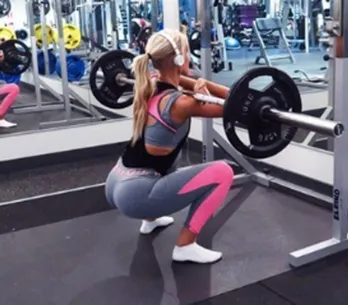Getting to know your 'normal' and regularly checking in with your breasts is an important way to find breast cancer early before it's obvious. Sure mammograms and screenings are effective (and should never be missed) but self-examination is just as vital to protect yourself.
Approximately 20 percent of breast cancers cases are found through physical examination rather than mammograms so getting into the habit of regularly examining your own breasts can be important way to look out for changes or symptoms.
A breast self-examination is an easy and important way to look out for your health - so get into the habit! It's as simple as TLC...
Touch your breasts. Can you feel anything unusual?
Look for changes. Is there any change in shape or texture?
Check anything unusual with your doctor.
Here's how to get familiar...
1. Look out for lumps
These might not be seen but they can be felt. But Sue Oliver, Professional Head of Mammography at Nuffield Health says not to worry, "Most breast lumps are not cancerous. A lump may be an indication of breast cancer or one of many benign breast conditions". Breast lumps deserve medical attention - if you find one - get it checked out!
2. Skin texture may change and become dimpled or puckered
This is more commonly known as 'peau d’orange' or 'orange-peel appearance' (puckered with little pits). This often comes with other symptoms such as redness and swelling and may indicate a sign of inflammatory breast cancer BUT could occur as a result of an infection or inflammation. The problem is, some women will avoid the doctors and try to talk themselves out of doubt. Never do this - always get it checked out!
3. The appearance or direction of the nipple may change
For example in direction, shape or pulled in (i.e. it could become inverted).
4. Discharge from your nipple
Know what's normal for you. Has the discharge suddenly come on? Being pregnant or breast feeding is the most obvious explanation for discharge but as you age your milk ducts become wider so discharge can be pretty normal for women over the age of 40. You may have milky discharge, yellow or green and blood stained discharge, whatever it is, it needs to be discussed with your doctor immediately.
5. Unusual thickening that doesn’t go away
6. Change in size and shape
Regularly check for signs. "You should ensure that your breasts are their usual size, shape, and colour. Also check that your breasts are evenly shaped without visible distortion or swelling," says Sue Oliver, Professional Head of Mammography at Nuffield Health. If you see any changes, bring them to your doctor’s attention.
Don't forget to check the upper chest and your arm pits! Many people tend to forget to check this area as it isn't an obvious part of the breast. Is there unusual pain or changes and skin texture? Once you know what normal for you, it's easy to determine.
7. Find a position you're comfortable with
Stephen Chan, Consultant Clinical Oncologist at BMI Park Hospital recommends leaning forward with your arms on your hips and then standing upright with both arms over your head."The more you do this the more you will get to know your breasts which, in turn, will make spotting changes easier," says Stephen.
8. Know the facts
Never miss an opportunity to get checked out. These procedures are put in place to benefit you so make sure to take advantage. There is a common misconception that mammograms expose you to too much radiation and that they increase your risk of cancer. But Sue says, "Yes, radiation is used in mammography but the radiation risk is outweighed by the benefit of the mammogram when used to diagnose a cancer. The amount of radiation received in a mammogram is the same as in a return flight from London to Australia." It's all about risks versus advantage.
9. Snooze often
And we're not talking every minute of everyday but we know for a fact that sleep isn't in a lot of people's priorities these days so make sure you're getting enough.
Sue says, "Sleeping longer can reduce your breast cancer risk. It is one potential reason that shift workers are more likely to develop breast cancer related problems." So know your stuff! A lack of sleep could be costing your health.
10. Switch up your routine
Moving around means you're getting the best of every angle. Stephen says, "When you are feeling for changes make sure you check in two or three different positions – laying on your back, standing up and leaning forward." It may sound like a lot but once you get yourself into the habit it will only cost you a couple of minutes of your time.
11. Birth control
It's important to know that some things may increase your risk of breast cancer so make sure you consider the risks before taking the plunge. And birth control is one of the inevitable things.
Sue says, "Taking hormone tablets such as HRT and oral contraceptives can increase your risk of breast cancer. Evidence suggests that the longer you take them the more your risk increases." Make sure you're aware of the risk and give your doctor as much family history as possible so you know you're taking the best contraceptive suited to you.
12. Know 'when'
Stephen says, "You wouldn’t go a month without brushing your teeth or washing your hair so why would you go a month without a breast check?" The best time do a breast self-exam is about one week after the start of a period but any time is better than none!
Get in the habit of checking in with your boobs at least once a month. This will give you the chance to get to know your breasts and learn how they normally look and feel. A good place to start is in front of a mirror which will give you a 360 degree view of your breasts.
A good way to remember is by downloading an app, like Keep A Breast, which guides you through the motions and even enables you to set a reminder to remind you to check. Make sure to visit BMI's self-help website here where you can get all the information you need about getting friendly with your breasts.
13. Lower your risk!
Sue says, "There’s a lot that women can do to lower their risk, including losing weight if they’re obese, reducing their fat intake, getting regular exercise, lowering alcohol consumption and quitting smoking."
14. Check them in the shower
Loads of women find this technique useful when doing a self-exam. Sometimes it's easier and more comfortable to check your breasts when their wet and slippery. Do what feels right for you!
15. Remember, minutes don’t matter when you could be saving your own life!
For more information visit Breakthrough.org.uk or to download your free ibreastcheck.com
You might also like:
Do You Know Your Normal? Be Breast Aware With A #CHECKYOURSELFIE













